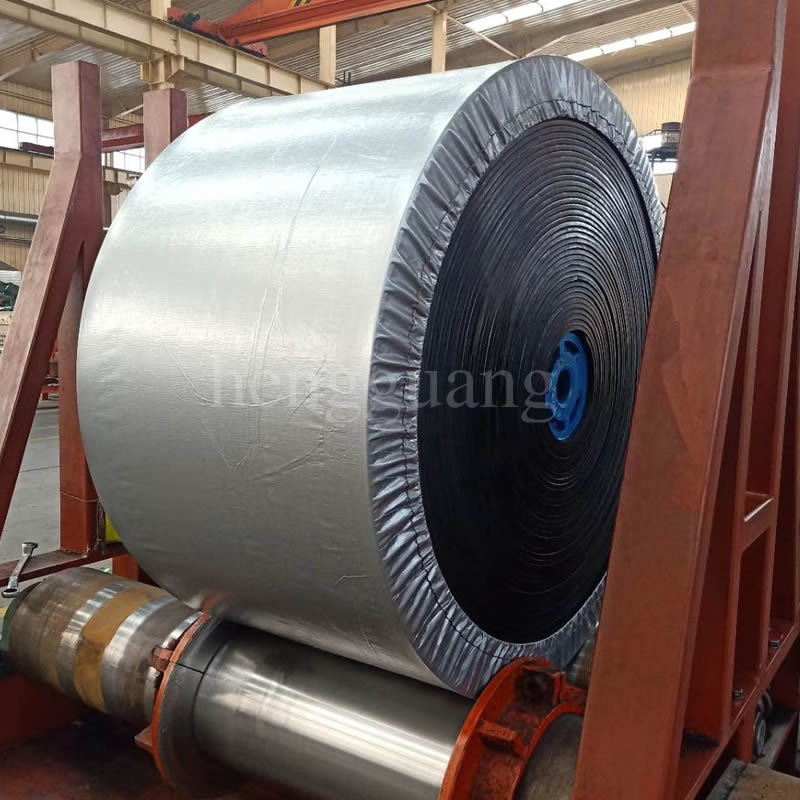Jan. 15, 2020
Conveyor belt is the core component of belt conveyor. It is both a traction member and a load bearing member, and it is expensive, accounting for about 30% to 50% of the entire belt conveyor cost. Once the conveyor belt becomes thin due to abrasion, it is followed by failures such as reduced strength, shortened life, and misaligned belts.
The belt conveyor machine manufacturer analyzes the wear patterns in 4 different situations, and puts forward some maintenance measures based on the actual production.
01.Abrasion between the feeding chute and the conveyor belt
The feeding chute is in close contact with the conveyor belt. Its design and installation have a great impact on the wear of the conveyor belt, and it is the main manifestation of the wear of the conveyor belt.
1.Wear causes
a) When feeding, the material has an impact on the conveyor, especially when the angle between the material and the direction of the conveyor is greater than or equal to 90 °, which will cause strong wear to the conveyor;
b) In order to prevent the material from being scattered, the material guide plate is in too close contact with the conveyor belt, causing the conveyor belt to wear;
c) The long and hard objects in the material are stuck at the feeding port, and they wear or scratch the conveyor belt.
2. Maintenance measures
In order to minimize the wear of the conveyor at the feed port, the structure design of the feed port should meet the following conditions:
a) The feeding and the mining conveyor belt run in the same direction, during the feeding process, the material moves at almost the same speed as the conveyor belt;
b) The equivalent free fall height of the material falling on the conveyor belt is less than 1m, so that the impact force on the conveyor belt is as small as possible;
c) A sieve is installed in the feeding chute to enable the fine-grained materials to fall on the conveyor belt first and provide cushioning for large materials;
d) Design reasonable chute and guide trough, so that the material can continuously fall to the center of the conveyor belt;
e) The width of the baffle of the material guide trough becomes narrower and narrower along the running direction of the conveyor belt. In addition, the material guide trough should extend to the speed of the material to reach the belt speed;
f) The feeding section is kept horizontal, or the inclination is not greater than 8 °, and the feeding section is equipped with a buffer idler or a grooved idler is arranged in an encrypted manner.
In addition, the chute and the guide trough should be firmly fixed so that they are correctly positioned against the conveyor belt, and the guide bottom cannot be too tight against the conveyor belt.
02, redirecting the wear between the roller and the conveyor belt
The redirecting roller is located at the rear of the conveyor, and the conveyor belt rotates with the redirecting roller, so that the lower conveyor belt becomes the upper conveyor belt to carry the material.
1.Wear causes
The abrasion is mainly due to debris entering between the redirecting roller and the conveyor belt, which is adhered to the roller, and the local radius of the redirecting roller is deformed and abraded. The main reasons are:
a) Because the cleaning is not clean and the environmental impact, the redirecting roller is easy to stick materials. When these materials reach 3cm, the local stress of the redirecting roller increases rapidly, and the abrasion between the two increases, making the adhesive layer of the conveyor belt thin or a hole.
b) There is a long unsupported section between the redirecting roller and the lower supporting roller. At this time, the shape of the conveyor belt gradually changes from a trough shape to a linear shape, and the materials easily fall down and fall on the empty section of the conveyor belt, enter between the conveyor belt and the roller, causing the wear of the conveyor belt.
2. Maintenance measures
a) Install a scraper plate near the surface of the reversing roller. The scraper plate and the receiving plate are welded together. The receiving plate is connected to the conveyor frame by bolts, and the scraper plate and the drum are inclined. Angle to increase scraping capacity.
b) Install a V-type cleaner on the front of the reversing drum (connected to the frame by bolts), and install rubber strips at the contact ends of the cleaner and the conveyor belt to reduce the wear on the tape. In addition, for the problem of material leakage in the unsupported section before the redirection of the drum, a baffle can also be installed in the unsupported section to reduce material leakage.

Mining Conveyor Belt